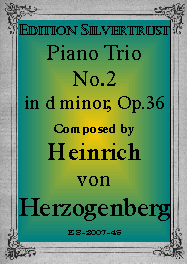Presents
Heinrich von Herzogenberg
Piano Trio No.2 in d minor, Op.36
 "A
composer of great refinement. He in his way was an original thinker and a
musician of genuine emotional and poetic qualities. His chamber compositions in
particular stand out among his hundred or more published works, for they are not
only masterly from the technical point of view, but interesting on the
intellectual side. As for the Op.36 piano trio, it is innocent of artificiality;
it is unaffected and natural, both in inspiration and in character."
"A
composer of great refinement. He in his way was an original thinker and a
musician of genuine emotional and poetic qualities. His chamber compositions in
particular stand out among his hundred or more published works, for they are not
only masterly from the technical point of view, but interesting on the
intellectual side. As for the Op.36 piano trio, it is innocent of artificiality;
it is unaffected and natural, both in inspiration and in character."
So wrote, Wilhelm Altmann, one of the most respected chamber music critics of the 20th century.
The Austrian composer Heinrich von Herzogenberg (1843-1900) has sometimes been attacked as nothing more than a pale imitation of Brahms, of whom he was a great admirer. There is no denying that his music often shows the influence of Brahms, however, listeners and players alike have discovered that it is original and fresh, notwithstanding the influence of Brahms. Most of his chamber is first rate and Brahms might well have wished he had written some of it. Toward the of his life, Brahms, who was not in the habit of praising other composers publicly, wrote of Herzogenberg, whom he had often harshly criticized in the past, “Herzogenberg is able to do more than any of the others."
Piano Trio No.2 dates 1882 and is in four movements. The first movement, Allegro, from its opening notes conveys a downtrodden sense of defeat. The tempo, in keeping with the mood, is moderate. It is only with the introduction of the second theme in the cello that hope is injected into the music. The lovely and highly romantic Andante brings with it fond memories of beautiful bygone days. The opening pizzicato of the strings in the third movement, Allegro molto, establishes the ghostly atmosphere of this lumbering scherzo. The formal musette trio section provides an excellent contrast. The Brahmsian opening theme to the finale, Allegro moderato, begins in a restrained manner, but quickly picks up momentum and a more joyous, even boisterous, mood is established. The buoyant and lyrical second theme helps the music sail forward effortlessly. Several dramatic climaxes at least lead to the magnificent, sweeping coda.
This is a work of the first order. It truly belongs in the repertoire. Professional groups would do well to present it and amateurs will derive great pleasure putting it into shape.
Parts: $29.95